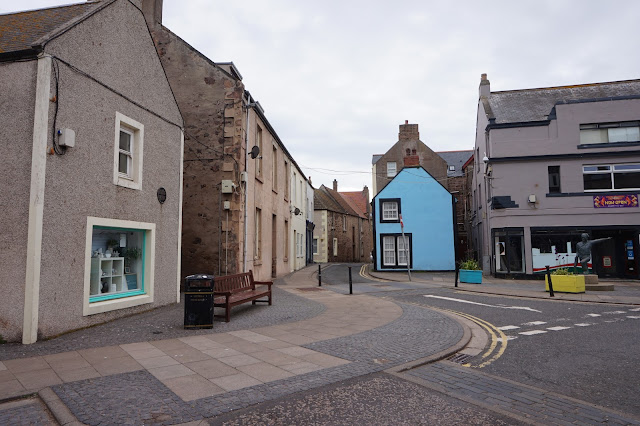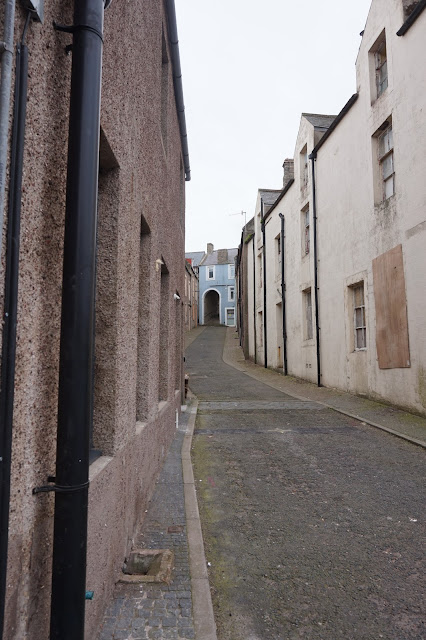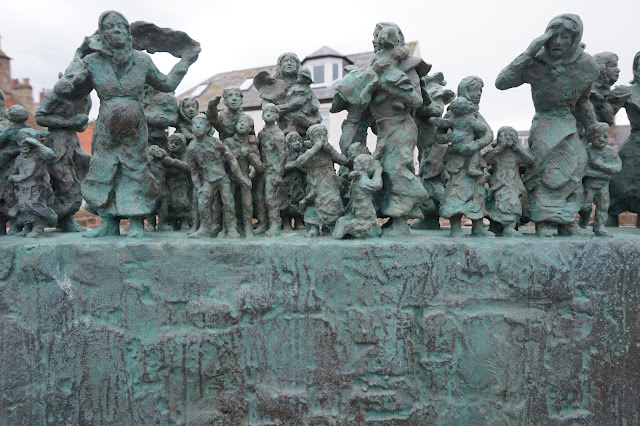It's a place that certainly made my feet happy!
It began raining as I walked, but that just made everything even more beautiful.
I also explore the bluffs on the south side of Eyemouth -- did that on my last evening in town -- and I found it to be even more beautiful than the above. I didn't take as many pictures here, as it was quite late at night when I did this little walk. I wish I hadn't been so tired when I arrived here Saturday because spending more time exploring this area would have been a delight!
I loved being able to look out over the sea and see the rain storms out over the water.
If I ever return here, I'd love to come out to this bench and just sit and look out over the sea for a couple of hours.
I mentioned in my post on Fast Castle from this trip that this town was rife with smuggling activity at one time. From what I understand there are still tunnels under the town relating to the smuggling. I also heard that the layout of the streets and buildings helped to support this, but I don't remember anymore where I read that.As with all towns I have been to in the UK, there is a war memorial, honoring the men who gave their lives in WWI and WWII. Eyemouth is a tiny fishing village. To have lost this many men from such a small town must have been particularly devastating.
Then I noticed another sculpture - couldn't quite make out what it was at first, but then I got closer. I've posted quite a lot of pictures of this because it really impacted me. It has to do with a great storm in 1881 that took the lives of many fisherman, leaving many widows and children behind. So this town has known far more than it share of loss!
I find the anguish on the faces sculpted below to be so palpable.
There is an inscription on the plaque that reads -
"During the afternoon of 14th October 1881 Eyemouth lost 129 fishermen and 20 boats, half of its fishing fleet, in a great storm. This monument celebrates the 78 widows and 182 bairns left behind. Their tenacity and endurance rebuilt the community and its fishing industry."
Each figure on this monument represents an actual person.
This loss happened only about 30 years before World War I, so they experienced loss after loss!
It's hard to write more while considering the immensity of that.
Though next up is the local museum, which also had quite a lot of information on this tragedy.
This area involves agriculture as well as fishing, and the museum really had quite a bit to it despite its small size. It seems to have been mostly focused on life in the 1800s in this area.As well as covering life here, there were multiple displays relating to the death toll of the Great Storm of 1881.
Here too, each figure represents an actual person. The figures standing alone or in groups of two are of those washed overboard (some within sight of shore). The larger groups represent those whose ships went down and they with them. (I'm starting to cry as I write this! It's such a heartbreaking story.) These are the "Pickit Men" because they are those who were picked or plucked suddenly out of this life.
Eternal Father, strong to save,whose arm doth bind the restless wave,who bidd'st the mighty ocean deepits own appointed limits keep:O hear us when we cry to theefor those in peril on the sea.O Saviour whose almighty wordthe winds and waves submissive heard,who walkedst on the foaming deep,and calm amid its rage didst sleep:O hear us when we cry to theefor those in peril on the sea.O sacred Spirit, who didst broodupon the chaos dark and rude,who bad'st its angry tumult cease,and gavest light and life and peace:O hear us when we cry to theefor those in peril on the sea.O Trinity of love and power,our brethren shield in danger's hour;from rock and tempest, fire and foe,protect them whereso'er they go:and ever let there rise to theeglad hymns of praise from land and sea.

















































No comments:
Post a Comment